Hannes accompanied me for some distance on his mountain bike as I set off along the 200 km highway between Pokhara and Kathmandu. The road condition was mostly good, and there wasn't too much honking (I wore earplugs nonetheless!).
Aiming to cover as much ground on the first day of what should be a two day journey, I rode relentlessly the hilly road, which tracked Himalayan river courses for most of its length. Maoist propaganda and Communist flags appeared from time to time, recalling the bloody insurgency that had so recently passed. Checkpoints were more frequent than further west, although they paid little attention to cyclists. The volume of trucks and buses grew progressively - a necessity for this nation almost devoid of railways.
Some time after dark, when joints and muscles and contact points ached and refused to operate correctly and I was starting to wonder if I actually had a plan, a motorcyclist came to my rescue, true to tradition! Basu spotted me on the dark highway and dissuaded me from continuing with an offer to come and stay with his family a few kilometres back up the road. We used a tow-rope to get my bike up the steep track to his place, where a large meal of dhal-bhat awaited.
I spent a couple of days with Basu and his family to give the tendinitis in my knee some reovery time. The village was tight-knit and friendly, and relatives or neighbours could and would turn up at any moment, and be welcomed. Yelling jokes to neighbours was common, as was chatting by the water tap. They worked hard, but seemed to have about everything they needed, and earned some money by selling some of their surplus harvest and animals they raised. Basu also worked in the tourism industry and had done stints working overseas. His three brothers were all working abroad to support their families - a common practice for Nepalis, even when it means not seeing the spouse and children for years. Nonetheless, the rest of his family and the others around them seemed to live more or less probably as most Nepalis had lived for centuries.
We hoed a plot of land. We prepared and sowed a rice paddy with Basu's father, an energetic 67 year old (in spite of his copious use of the Nargila pipe!). We moved a ton of rocks in preparation for an extension to the house. There was some teasing at first, and despite feeling energetic enough I had to stifle the urge to 'prove' myself in light of being both a westerner and a city-dweller; I needed to ensure I wasn't worn out for the remaining 80 km to Kathmandu, most of which would be uphill.
For the second time in this voyage I was offered land to farm and live on. Tempting it was, but not so amenable to my aim of returning to NZ to be closer to my family!
Farewells said, the climb soon began and didn't stop until, after a killer gradient for the final few kilometres, the Kathmandu valley stretched before me. I finally stopped to eat some lunch (the sun was close to setting) and descended into a maelstrom of frenetic traffic, smog and terrible roads. Reaching the Thamel area, a favourite of backpackers, I located a good hotel with WiFi and started to ponder what I would do next.
I spent several days doing not much before starting to address the problem of how and where to go next. In my daily outings, young men on every street corner, and many places inbetween, would surreptitiously sidle up to me as I passed and whisper "hashish?" in my ear. Most wanted several "Nos" before leaving me alone. Any short walk would entail half a dozen such encounters, although looking as I presently do, perhaps I got more offers than is normal!
Thamel's streets are a little claustrophobic, being very narrow and bordered by tall buildings everywhere. The usual deft sidestepping of cars, tuk-tuks, rickshaws and motorcycles is vital to staying in one piece. Every surface or piece of airspace sports a sign in bold English advertising tours, tickets, massage, money exchange, etc. Shops full of authentic, sometimes misspelt, cheap Chinese knock-offs of hiking and camping gear are common. Every type of western food is available.
The load-shedding continued, and I planned my days somewhat to maximise access to electricity for my twin vices, coffee and Internet.
A travel agent confirmed what the wonderful Kiwi Kyles (she of solo bicycle world tour fame) had told me: that it was possible to enter China from Tibet from Nepal if one bought a train ticket from Lhasa to mainland China first. It wasn't even necessary to do an expensive guided tour of Tibet, where minders would keep one away from anything that might reflect badly on the political situation. Assuming other passengers could be found, a jeep or minibus could take me directly to Lhasa, where I could board the train. It would cost around US$600 for the journey to Lhasa and train fare. Ouch!
Then it emerged that no travel permits to Tibet would be available until at least April, almost a month away. I had a little over a week on my Nepali visa left, but could extend it at some expense. It must be said that I wasn't enjoying just sitting around in Kathmandu, although there is plenty to see for the more dedicated tourist. The travel agent offered the chance to work as a volunteer in a village somewhere until Tibet travel permits were available. After mulling for several days, I ultimately fell on the option that was easiest and cheapest (except in terms of eco-cred) - that of flying to Bangkok.
Returning to my hotel some days later with cartons for a bicycle box under my arm, I was spotted by Yuji, whom I'd met at the Vipassana course in Jaipur, and again in Pushkar. It was great to see him again, and made me feel a little less alienated in Touristville. Incidentally, he and a friend named Daigoro mentioned they wanted to oppose a proposed new nuclear reactor in Japan, which in light of the tsunami of March 11th takes on a whole new significance! I expect their efforts may no longer be required, although Japan doesn't have too many alternatives for large-scale generation.
Over the next days we hung out a bit, compared notes, and discovered we'd both found the cheapest local restaurant independently, Yuji's committment to frugalism being perhaps the equal of my own.
On the day after Tibetan New Year, Yuji and sardined into a packed public minivan and visited Boudhanath (see more info), the largest Buddhist stupa in Nepal, nestled in a bustling Tibetan neighbourhood. Yuji craftily led me into the square via a side entrance, thereby avoiding a hefty 'tourist tax' at the main gate.
Inside, monks in crimson robes mingled with tourist and layperson alike as a pair of disembodied 'Buddha eyes' watched over all from the central tower, somewhat ominously. Locals threw buckets of fresh paint over the stupa's white dome to mark the new year.
I learnt more of Tibetan Buddhism there; of its ritualistic bent and mystical underpinnings. Rotating drums ('Prayer Wheels') bearing excerpts of holy texts allegedly gave merit, when spun clockwise, equivalent to a full reading of the sutras on which they were based. Incense and food offerings to various Boddhisatvas earned happiness, prosperity, merit, forgiveness. Walking clockwise around the stupa itself would bring material benefits in this life. Something of a departure from the aspects of Buddhism I'm more familiar with, but not too dissimilar from developments and deviations seen in all other faiths.
Packing my bicycle and luggage accounted for most of the remainder of my time in the valley. And then it was time to fly.
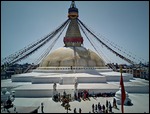


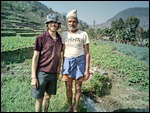
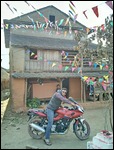
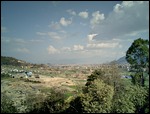
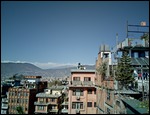
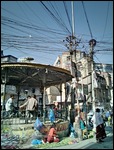

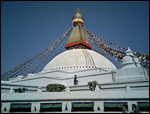
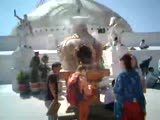
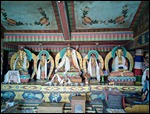
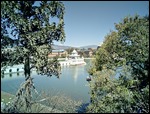
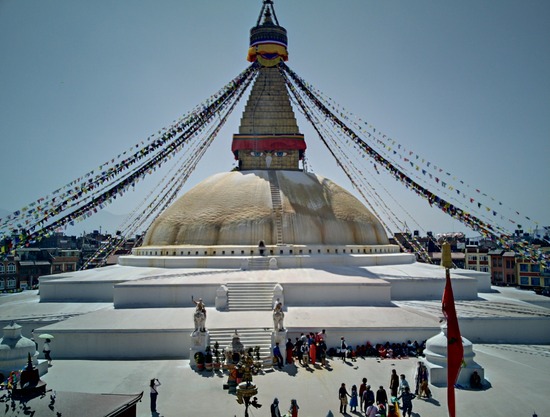



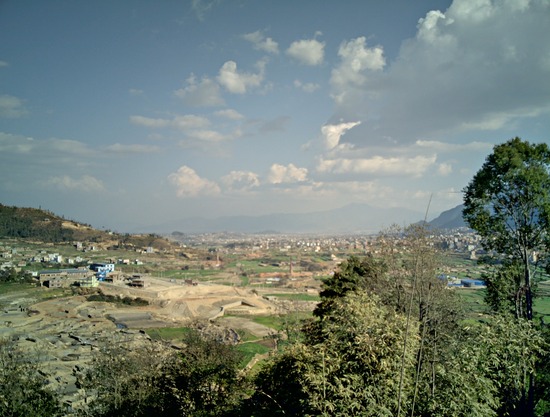
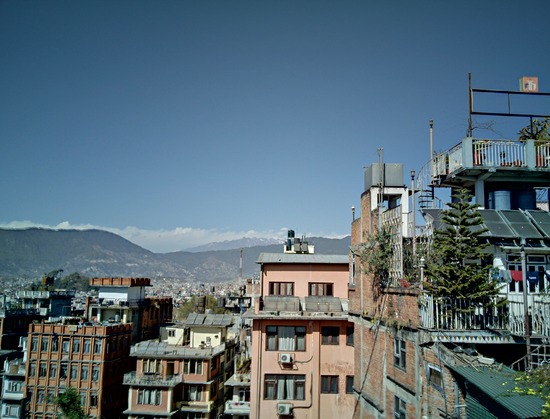
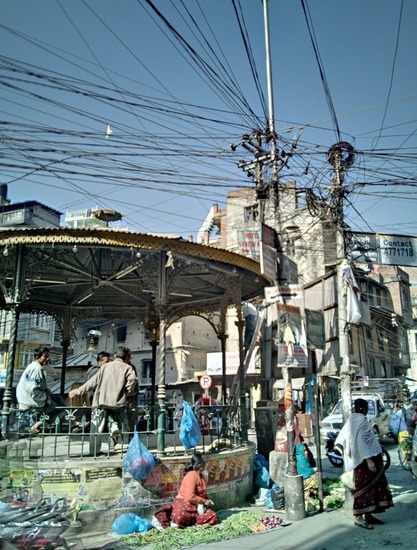
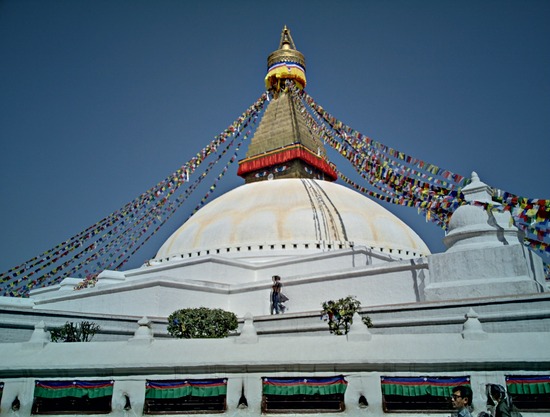
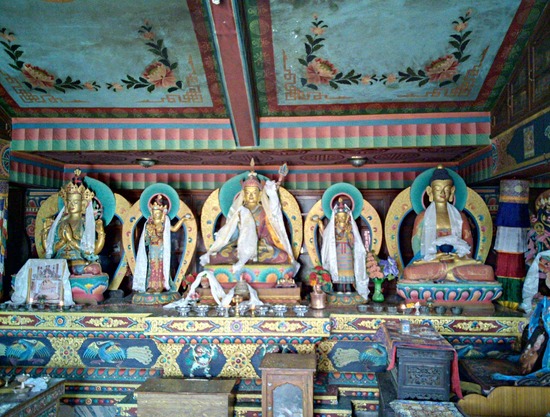
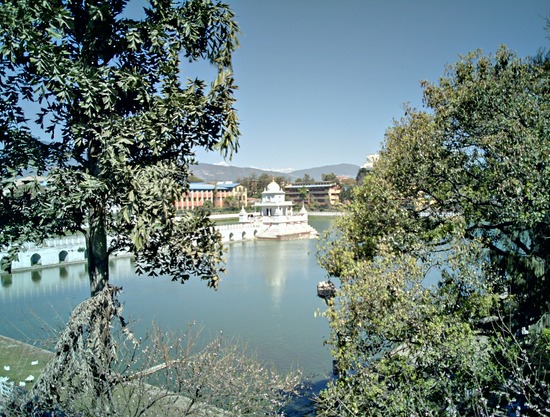
Comments